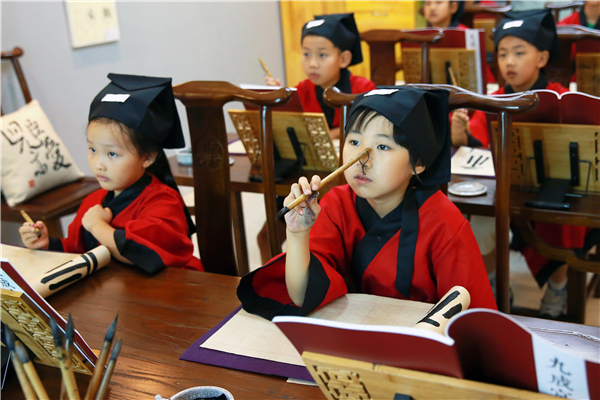
Children learn calligraphy at a training course held by Han Calligraphy Education this summer in Beijing. More and more children take the training during their summer vacation. [Photo/China Daily]
After donning an apron and folding a piece of paper both horizontally and vertically, 10-year-old Jia Jia stood in front of his desk, dipped a writing brush in ink and began to form the Chinese characters for zheng zhi-integrity.
This is the second time the fourth-grade pupil has taken a calligraphy class and he is currently learning seal script, an ancient style of writing Chinese characters that arose during the Qin Dynasty (221-206 BC). In the eyes of Jia Jia’s teacher, he is progressing quickly.
In recent years, an increasing number of students like Jia Jia have been flocking to calligraphy institutes, as traditional Chinese writing styles garner more attention both at home and abroad.
Li Xiaoya, founder and president of Han Calligraphy Education, a leading teaching institute in Beijing, said that when she started the business seven years ago, it mainly focused on teaching adults. Soon they started to add courses for children, however, after they noticed a gap in the market.
“A series of preferential policies carried out in recent years have also helped calligraphy attract attention and interest from more children and their parents,” Li said, citing as an example an Education Ministry directive, first issued in 2013, that urges China’s primary and middle schools to make calligraphy part of their curriculum.
To date, the institute has registered upward of 10,000 learners and more than half are children. The summer vacation brought even more young learners, Li said.
Benefits of calligraphy
Jia Jia was one of them. His mother, Li Li, believes that practicing calligraphy will help improve her son’s knowledge, handwriting, learning habits and state of mind.
“Calligraphy, as a type of traditional Chinese culture, contains a lot of philosophy and wisdom,” she said. “My son can learn many things during the whole process, whether it’s a lecture on traditional Chinese culture or holding and wielding the writing brush.”
Liu Chen, a teacher at HCE who has been practicing calligraphy since he was a first-grader, said learning traditional writing styles can help with young people’s development.
“It can make children who are mischievous more calm and composed. Also, because learning calligraphy requires observation skills, children will become more attentive to details in daily life,” the 26-year-old said.
“In addition, as calligraphy has its own standards and emphasizes self-discipline, children will become more self-restrained after practicing it for a period of time.”
Liu has also noticed that children require a different teaching approach than would be used with adults.
“You need to be more patient and caring, and use simple words that they can understand,” he said.
Appeal to children
In order to meet these special demands, Li Xiaoya said they had developed a comprehensive teaching system for young learners.
It divides all the required calligraphy techniques into smaller modules that are taught to children one at a time, using simple, understandable words.
“We also hold a strong belief that when learning calligraphy, children should learn how to use their eyes to observe before they use their hands to write. They should know what calligraphy is good and what is not good enough,” Li said.
As well as classroom teaching, HCE also organizes events to make calligraphy more appealing to youngsters.
During the summer vacation, for example, the institute took young learners to Xi’an, Shaanxi province, to visit the Beilin Museum, or Forest of Stone Steles, which houses the works of many well-known calligraphers from ancient China.
“We also hold exhibitions annually to display our students’ works,” said Ning Kejun, another HCE teacher. “The exhibitions make them very proud and more confident in their learning of calligraphy.”
